Pelvic organ prolapse (POS)
Pelvic organ prolapse (POP) is common, and can affect women young or old, most commonly post-natally. Almost one in five Australian women will need surgery for prolapse during their lifetime.
Home / Pelvic organ prolapse (POP)
Types and symptoms of pelvic organ prolapse
There are 5 types of pelvic organ prolapse: rectocele (large bowel), cystyocele (bladder), enterocele (intestines), vaginal vault (occurs after a hysterectomy), and uterine (uterus). There are also stages of prolapse; stage 1 to stage 5.
Each of these 5 types of POP has its own symptoms, but in general symptoms can include:
- Pressure, pain, or fullness in vagina, rectum, or both
- Urinary incontinence, stress incontinence
- Constipation
- Lower Back, pelvic or abdominal pain
- Lack of sexual sensation or painful intercourse
- Can’t keep a tampon in
How does exercise help with pelvic organ prolapse?
Whether you are a candidature for surgery, or during rehabilitation from surgery, exercise has an important role in reconnecting and strengthening your pelvic floor muscles and strengthening the musculature surrounding them. Specific exercise for prolapse can greatly improve and manage symptoms, however certain exercises are contraindicated for prolapse – and can make things worse.
If you aren’t sure where to start, get help from an Accredited Exercise Physiologist.

Things to remember
- Lighten your weights or resistance so that you don’t feel pressure down on your pelvic floor as you move.
- Avoid holding your breath by exhaling with effort (e.g. when you pull, push, lift or lower weights) using your ‘core’ breath (see Pelvic Floor exercises).
- Reduce the depth of your squats and lunges – aim to keep your hips at a higher level than your knees.
- Avoid all abdominal exercises (e.g. sit ups, curl ups, crunches, double leg lifts, and some Pilates moves) and instead chose abdominal exercises that resistance lateral and frontal flexion (eg. Pallof press, side planks)
- Maintain good posture.
- Choose supported positions (eg seated machines or sitting on a fit ball to use hand weights).
- Keep your legs closer together during exercise, no wide legged squats or squat jumps.
- Lift your pelvic floor before you move and relax afterwards.
- You may need to add some rests, or reduce the number of reps that you do in a row, while your pelvic floor muscle fitness improves.
What type of exercise is best for pelvic organ prolapse?
- Aerobic exercises three to five times a week (walking, cycling, swimming etc). Aerobic exercise helps your cardiovascular system, muscles, tendons and ligaments to stay strong and will also help you maintain to the correct weight (BMI) for your height and age.
- Resistance training two to three times a week. Resistance training is fantastic for increasing your muscular strength, and integrating your core into more functional tasks. Strengthening your glute muscles, hamstrings, adductors, lower back and abdominals can all help in gaining and maintaining pelvic floor strength. Exercises such as squats, lunges, or seated dumbbell exercises can achieve this. Keep rep ranges high (12-15) and dumbbell weights lower to begin.
- Pelvic floor exercises (also known as ‘kegals’) also have their place to help improve motor control of pelvic floor, however a program of kegals alone will not improve your symptoms or your pelvic floor weakness.
Frequently asked questions
What is an Accredited Exercise Physiologist (AEP)?
An Accredited Exercise Physiologist (AEP) is an allied health professional that prescribes individualised exercise therapy to help people manage their chronic conditions, disabilities, long-term injuries and so much more. They are the most qualified professionals in Australia when it comes to the prescription safe and effective of exercise therapy.
Who should see an AEP?
Anyone who wants to move safely and improve their health can benefit. From chronic conditions to injury recovery, or simply wanting advice on how to exercise right, an exercise physiologist is the expert to see.
Is an AEP covered by Medicare or private health insurance?
Yes. As allied health professionals, exercise physiology services are recognised in government health funding including Medicare, National Disability Insurance Scheme (NDIS) and Department of Veteran’s Affairs (DVA), workers’ compensation and private health insurers. It’s important that you check with your provider as coverage can vary.
Where can I find an AEP?
Use recognised directories like Exercise & Sports Science Australia (ESSA), ask your GP or look for allied health clinics with AEP credentials.
You may also like

What is Pelvic Organ Prolapse (POP)?
Almost one in five Australian women will be affected by pelvic organ prolapse (POP) during their lifetime. Many women may feel lost when it comes to moving well or returning to exercise with POP, but there are many ways to help return to movement that you enjoy whilst protecting your pelvic floor. Whether you are […]

